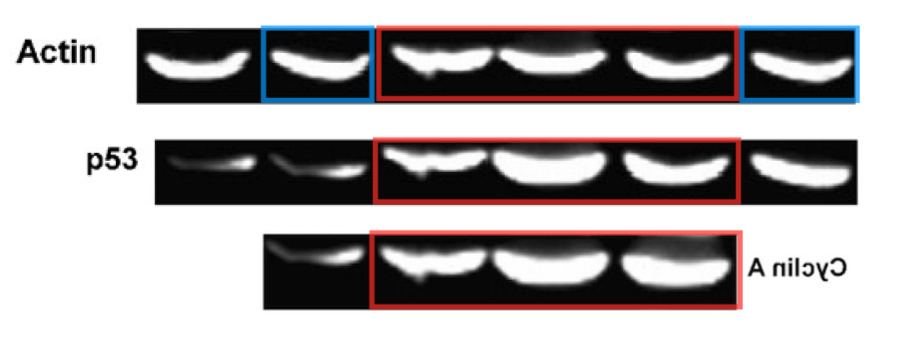In the past months I have been going through my spreadsheet with over 2,000 papers with image or other problems. Many of these papers were reported by me in 2014 and 2015 to the editors of the journals in which they were published. Now, around 5 years later, it is time to see what happened with my reports.
In this post, I want to show you an example of a paper that I reported in 2014, and that was corrected about a year later.
In my opinion, the Editors of the journal made a huge mistake here. This should have been a retraction.
The paper in question is Wang X et al., Silencing of human phosphatidylethanolamine-binding protein 4 sensitizes breast cancer cells to tumor necrosis factor-alpha-induced apoptosis and cell growth arrest – Clin Cancer Res 2005;11(20) October 15, 2005 – DOI: 10.1158/1078-0432.CCR-05-0879.
Clinical Cancer Research is a pretty high-impact-factor journal (10.2 in 2017, according to Wikipedia). The paper has been cited 48 times, which counts towards the journal’s impact factor. The paper was supported by a grant from the National Natural Science Foundation of China, so that is also pretty big.
The correction to the paper reads: “In this article, … the Western blot panels, flow cytometry, and RT-PCR panels presented in Figs. 1A, 3B–E, 4, 5A and 5E were incorrect. The authors have provided new versions of these figures (below)….. These changes do not affect the interpretation or conclusions of this work. The authors regret this error.”
Let’s take a look at the original version of these incorrect figures. Here is Figure 1A, in which all eight b-actin bands appear to look the same (shown in yellow boxes).

Figure 1A was labeled as “incorrect” in the correction, so it is fair to assume that what the similarities that I saw were indeed lane duplications. Something that does not happen by accident.
Here is the original Figure 3B, Actin panel. I reported that lanes 2-5 looked remarkably similar to lanes 9-12. Shown with red boxes. The right-most lane looks a bit different, but the other three bands have characteristic shapes that one would not expect to see twice within the same photo.

Figures 3C and 3D showed some flow cytometry panels that looked … unusual. The same areas appeared to be visible multiple times within the same panel, or between panels. Boxes of the same color were added by me to highlight areas that looked identical or highly similar.


In Figure 3E I had noticed that lanes 1-5 in the Actin blot looked unexpectedly similar to lanes 6-10. Shown here with green boxes.

Figures 4 and 5 appeared to have some duplication issues as well. Here are the ones that I noticed and reported.


Almost of these duplications belong to category III, as defined in our 2016 mBio paper. In our paper we defined three categories of duplications. Category III, “duplication with alteration” is defined as photos or graphs with duplicated features, such as gel or blot bands, groups of cells, or datapoints or evidence of other photo alterations. It is also the group of duplications that we believe are the most likely to have been done intentional. I can think of very few honest errors that could explain how the same bands or groups of cells could be visible twice within the same photo.
This paper contains five figures. All five figures contained duplications that appeared to have been done intentionally, not by honest errors.
The editors of the journal accepted the simple explanation by the authors that the figures were “incorrect” and published the correction. No critical questions were asked, no retraction or expression of concern was issued.
This case is unfortunately not rare. It seems that editors rather want to go the easy route and accept a correction to address manipulated images, instead of being skeptical and retracting these types of papers.
It is especially frustrating to see how inconsistent editors or publishers are in deciding what type of action to take – if they take any action at all. I have seen papers being retracted for fairly minor duplications, while others with tonnes of duplications get away with a correction, or are left untouched.
There is definitely a need for better guidelines on when to retract or correct a paper. In my opinion, a paper that contains a photo that has been manipulated needs to be retracted. This paper had 14 manipulated photos.
You can read my PubPeer post about this paper here.


2 thoughts on “Mega-corrections and weak editors”